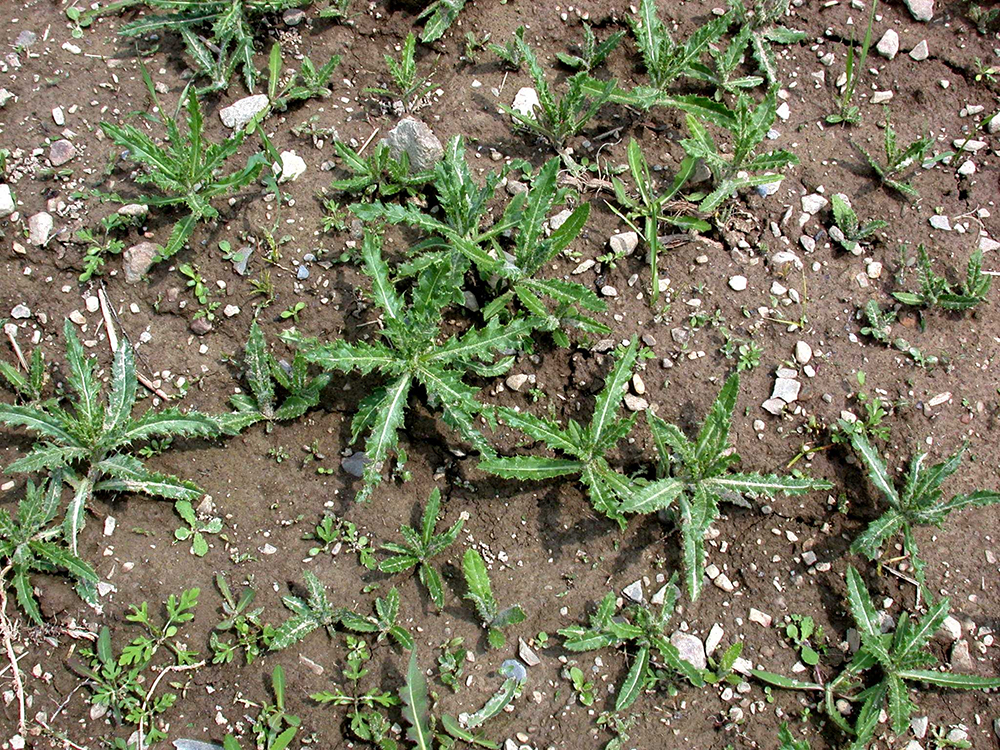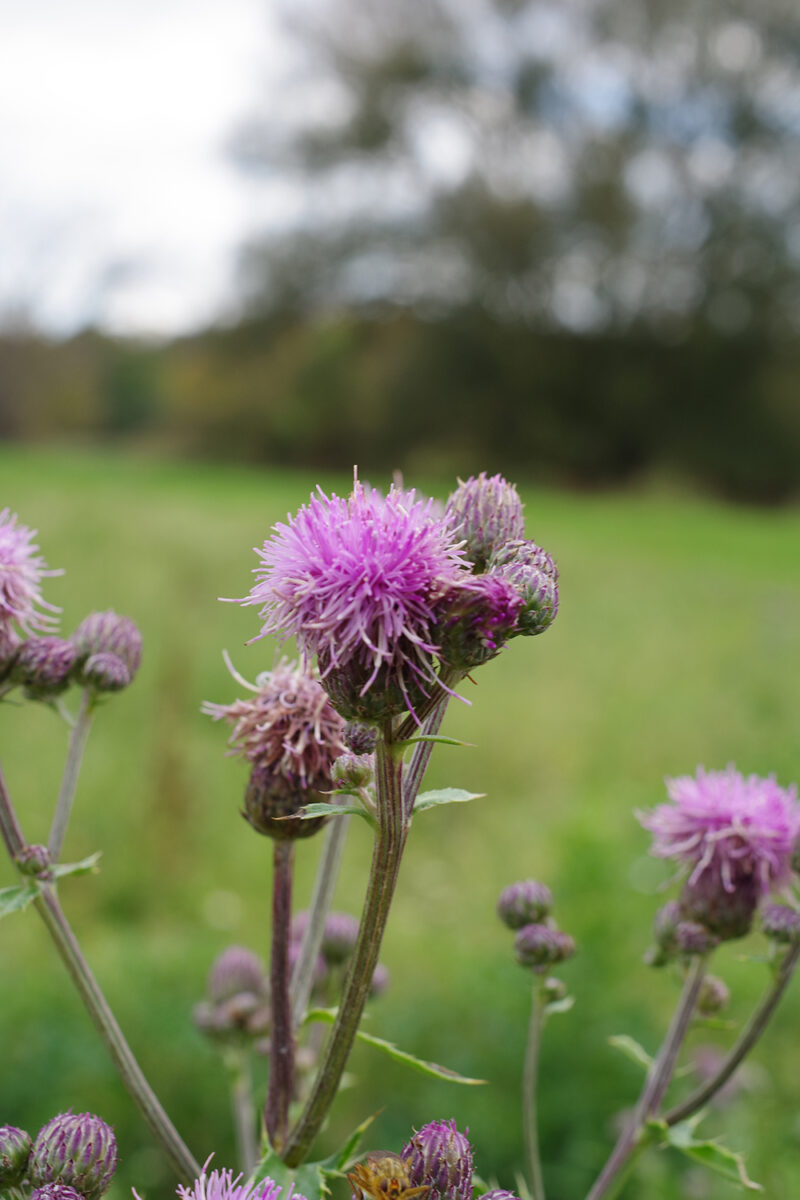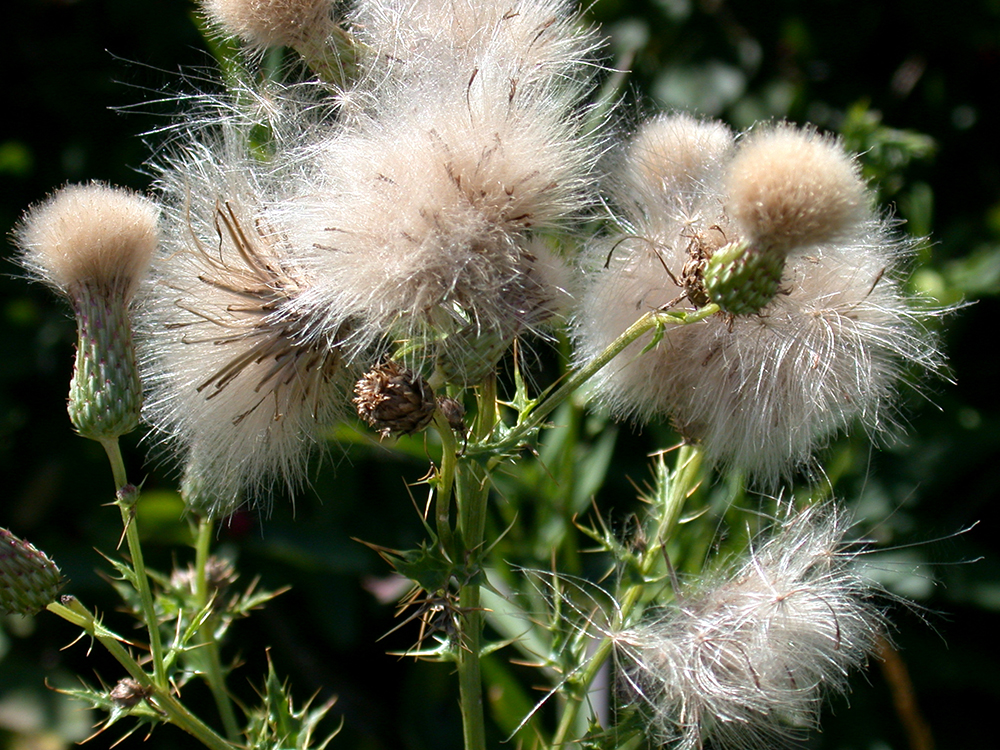Other common names: creeping thistle, small-flowered thistle, perennial thistle, green thistle, field thistle, cursed thistle, corn thistle



Cirsium arvense (L.) Scop.
Identification of Canada Thistle
Family: Aster family, Asteraceae
Habit: Prickly perennial herb spreading by deep thickened storage roots
Description: Cotyledons of the seedling are stalkless, fleshy, hairless, oval to rounded and 0.2–0.6 inch long by 0.1–0.2 inch wide. The first true leaves of the seedling are egg shaped to lanceolate, hairy and have irregularly lobed, spiny edges. The early leaves form a rosette before bolting. Seedlings begin to develop horizontal storage roots early, and a plant with only two true leaves may have a perennating storage root up to 6 inches long. Vegetative buds develop on the storage root by the third true leaf stage. Mature plants are 1–5 feet tall and branched towards the top. Stems are hollow, grooved and sparsely hairy to smooth. Leaves are 2–6 inches long, alternate, oblong and irregularly lobed with sharp spines along the edges. Upper surfaces of the leaves are hairless, dark green and waxy, while lower surfaces are pale green and smooth to hairy. The leaves are stalkless and clasp the stem at the base. The roots are an extensive system of white, fleshy storage roots that can extend to over 15 feet horizontally and vertically and can produce more than 200 new buds annually. Vegetative shoots resemble seedlings but are larger and lack cotyledons. Male and female flowers are produced on separate plants in leaf axils and at the end of branches. Male flower heads are round and 0.5 inch wide, while female flower heads are 1 inch wide and flask shaped. The flowers of both sexes are purple-pink, with bases enclosed in overlapping triangular or diamond shaped, scale-like, spineless green bracts. A small leaf is present at the base of each flower stalk. Each female flower head may produce as many as 45 seeds. The apparent seeds have a thin dry outer coating of fruit tissue. Seeds are brown, flattened, oblong and 0.1–0.25 inch long. Each seed is weakly attached to a feathery, white brown pappus.
Similar species: Many thistles and thistle-like plants have spiny leaves and similar flower heads to Canada thistle. Nearly all are biennial, however, and have taproots rather than the extensive storage root system of Canada thistle. Bull thistle [Cirsium vulgare (Savi) Ten.] leaves have hairy upper surfaces and spiny, winged stems, while Canada thistle leaves are hairless above and the stems lack wings. Sowthistle (Sonchus) species may look similar to Canada thistle. Sowthistles have yellow flower heads and bleed milky sap when damaged, while Canada thistle has purple flower heads and clear sap.
Management of Canada Thistle
Because Canada thistle has a deep root system, the only approach for controlling this weed is to exhaust the storage roots. Food reserves in the roots reach a minimum near the onset of hot weather when the shoots reach about 1 foot tall and then increase as energy flows from the shoots to the storage roots. Consequently, shoots should be removed for the first time by late spring. Repeated removal of the shoots before they attain several leaves will exhaust the storage roots within two years and eliminate the weed. Several studies found a 21-day weeding schedule was optimal. Since buds on the roots will continue to sprout well into the fall, persistence is required. A dense cover crop of sorghum-sudangrass or a mixture of sorghum-sudangrass with compatible species mowed once or twice during the season reduced Canada thistle shoot density and mass to less than 20% of initial values. Competition from pasture species maintained low Canada thistle populations, but populations increased substantially when released from competition. Accordingly, high intensity, low frequency grazing over two to three years provided better control than high frequency grazing for a short duration.
Long fallow periods may not be cost effective unless thistle pressure is severe, but growing crops that allow repeated cultivation close to the row achieves a similar effect for at least part of the season. Both spring and fall sown grain crops tend to promote Canada thistle due to the long period in which the shoots can grow without disturbance, but winter wheat is more competitive than spring grains. In a Danish study, cultivation of spring barley with shovels plus hand cutting of shoots in the rows greatly decreased Canada thistle. Because alfalfa is mowed several times per year over a period of several years, this crop is very useful for managing Canada thistle. Hay that is mowed only once per year is less helpful for managing this weed.
Control of established Canada thistle stands for one year is usually insufficient for long-term control. Generally, because established plants survive many years, multiple control tactics are required for multiple years. An integrated rotation was proposed for central Pennsylvania including three years of alfalfa followed by a three-year sequence of fall brassicas, early spring vegetables and a summer vegetable. On a Maryland organic farm, a program including two years of repeated summer cultivations followed by dense plantings of winter barley for haylage reduced a heavily infested field of Canada thistle by 76%, allowing transition to alfalfa followed by successful establishment of row crops with minimum Canada thistle populations after five years.
The root reserves are sufficient to push the shoot through any amount of loose mulch, and Canada thistle growth will benefit from the soil moisture conserved by the mulching materials. A tough synthetic tarp, however, can prevent shoots from reaching light. Transfer of energy into the dying shoots reduces vigor of the storage roots.
Preventive measures that reduce dispersal are an important part of any control strategy. Canada thistle growing along field margins, fence rows or drainage ditches can easily spread into fields unless eliminated. Because Canada thistle is often a problem in grain crops, thistle stalks, including mature seeds, are often present in baled grain straw. Similarly, manure that includes grain straw bedding is often contaminated with Canada thistle seeds.
Ecology of Canada Thistle
Origin and distribution: Canada thistle probably originated in southeastern Europe and the eastern Mediterranean. It has spread throughout Europe, North Africa, through central Asia to Japan, and across the northern United States and southern Canada. It is also naturalized in South Africa, New Zealand and southeastern Australia.
Seed weight: Population mean seed weights range from 0.95–1.7 mg.
Dormancy and germination: Most seeds are not dormant when shed from the parent plant, however some investigators report the need for chilling and after-ripening to achieve full germination. Seeds germinate best at warm daytime temperatures (77–86°F) but are inhibited from germination by hot (104°F) temperatures. Light, day/night fluctuation in temperature, and to a lesser extent, nitrate, all increase germination.
Seed longevity: A few seeds may persist in the soil for 17–21 years, but most disappear within the first few years. Seeds persist better when buried over 1 foot, and more poorly when near the soil surface.
Season of emergence: Seedlings emerge primarily in the spring, with some emerging in summer. Shoots from rootstocks begin emerging in mid-spring and emerge continuously until frost.
Emergence depth: Optimum depth for seedling emergence is 0–0.4 inch, but seedlings can emerge from as deep as 2.4 inches. Shoots can emerge from roots several feet deep, but the optimum depth for shoot emergence and plant canopy spread is 4 inches, compared to shallower or deeper depths.
Photosynthetic pathway: C3
Sensitivity to frost: Shoots tolerate light frost (as in spring) but are killed by hard frost (as in fall). The root system persists over the winter. Seasonally higher concentrations of sucrose and fructans in roots during fall and winter months allow the roots to adapt to cold temperatures. However, root fragments at the soil surface are killed by 14–21°F temperatures.
Drought tolerance: Well developed plants are drought tolerant due to their deep root systems. Shoot establishment and growth from root fragments are reduced by low soil moisture, suggesting that dry conditions can enhance control with tillage practices, and that areas with optimum soil moisture are more prone to proliferation of this weed. Competition for water between shoots and root buds is a primary cause of bud inhibition under dry conditions.
Mycorrhiza: Canada thistle is mycorrhizal and demonstrates a positive growth response to the presence of mycorrhiza.
Response to fertility: Nitrogen increased shoot growth of Canada thistle seedlings but decreased number of root buds initiated. In another pot experiment, nitrogen increased growth of plants derived from root fragments more than that of seedlings. In an Alberta field experiment, nitrogen increased root growth but not shoot growth. In Sweden, soil nitrogen content had little influence on growth or regenerative capacity of Canada thistle roots or shoots. In England, with reduced competition, nitrogen and phosphorus increased Canada thistle shoot stands, while potassium and magnesium had no effect. However, in the presence of pasture species, nitrogen favored the competing pasture grasses and resulted in suppression of Canada thistle. Phosphorus, in contrast, favored Canada thistle both with and without competition.
Soil physical requirements: Canada thistle tolerates a wide range of soil types. It does poorly, however, on wet soils, and is particularly vigorous on well drained, fine textured (clay to silt loam) soils suitable for agricultural production.
Response to shade: The species is shade intolerant, but due to its extensive root reserves, shoots can often grow through competing vegetation. Seedlings will die when light falls below 20% of sunlight. Shoots of established plants suffer when shaded by competing taller species.
Sensitivity to disturbance: Canada thistle is highly resistant to cutting, hoeing and even to deep tillage. The root system commonly extends to depths of 6.6 feet or more, and new shoots quickly reappear after the previous shoots have been removed. Carbohydrate reserves in the root system reach a minimum at about the formation of the flower buds, and the plant is most sensitive to removal of the shoots at that time. Plants arising from root fragments are most sensitive to disturbance when about eight leaves have formed. Plants arising from deeply buried root fragments (8 inches deep) have weaker regrowth potential than plants derived from shallow root fragments (2 inches deep). Root fragments larger than 0.1 inch or 0.05 ounces fresh weight will usually produce new plants, and smaller fragments may also if they are near the soil surface. A single cultivation event increases and disperses the population of propagating rootstock, thereby increasing the abundance of this species, so multiple cultivations or integration with additional suppression tactics are required for control. Shoot emergence from root fragments decreases in early fall, but production of underground shoots continues, suggesting that fall tillage could still be effective for reducing reserves. Seeds are unable to mature and become viable when stems are cut in full bloom.
Time from emergence to reproduction: Plants flower in response to long day lengths of 14–16 hours, generally between late June and August. Thus, plants emerging from rootstocks in spring take about eight to 10 weeks to flower.
Pollination: Canada thistle is pollinated by insects, especially honeybees. Since male and female flowers occur on separate individuals, the species typically cannot self-pollinate. Consequently, many infestations are single clones that cannot produce seeds.
Reproduction: Canada thistle reproduces both vegetatively and by seeds. Seed production varies from 0–5,000 seeds per shoot, depending largely on the thoroughness of pollination. This in turn depends on the proximity of male and female plants. Seeds mainly allow the species to disperse between locations and do little to maintain local populations. Seedlings become perennial from six to 10 weeks after emergence and can thereafter reproduce from sprouts of deep and rapidly spreading roots. In Alberta, by the end of summer, a single plant produced 26 aboveground shoots, 154 underground shoots and 364 feet of roots. Plots initiated with individual root fragments expanded to cover a 161-square-foot area, and roots penetrated to a depth of 4.6 feet in one year and covered 538 square feet to a depth of 7.2 feet in two years. Roots have approximately one to two root buds per 4 inches of root length throughout the year. Root fragments from a 10-year-old stand of Canada thistle had the capacity to produce a similar number of shoots per unit of root, regardless of their location along the 6-foot rooting depth of the stand. Development of underground shoot length is greatest in late fall and winter following death of aerial shoots as the plant becomes primed for shoot emergence when soil warms in spring.
Dispersal: The seeds have a special feathery structure (the pappus) that aids in wind dispersal. The efficiency of wind dispersal is low, but it ensures introduction to new sites and maintains genetic diversity. Canada thistle is common in field borders, which undoubtedly serves as a source of field contamination both by seeds and spreading roots. The seeds also commonly disperse in contaminated crop seed, hay and straw used for livestock or for mulch and compost in gardens. Seeds can blow into irrigation or drainage waters and then be transported long distances while maintaining 52–65% viability.
Common natural enemies: Goldfinches and other birds eat the seeds. Numerous nematodes, insects and fungi have been identified on Canada thistle; a selection of these organisms is discussed below. Four species have successfully established as biocontrol agents on this weed, including Hadroplontus litura, Urophora cardui, Larinus carlinae and Rhinocyllus conicus, but their impact is typically limited overall. Larvae of painted lady butterfly (Cynthia cardui) can defoliate the plant. Larvae of Canada thistle midge (Dasypeura gibsoi) eat the seeds, and larvae of Orellia ruficauda attack the flowering heads. None of these organisms is sufficient to control Canada thistle alone. The weevil Ceutorhynchus litura has been released in Canada as a biocontrol agent. Larvae mine the leaf veins, stems and root collar, and can greatly reduce a population, but the insect is difficult to get established. The gall fly Urophora cardui deposits eggs and produces galls in terminal shoots of Canada thistle but has had little impact on thistle populations despite successful colonization after release in eastern Canada. The shoot-boring weevil, Apion onopordi, infested and reproduced in Canada thistle shoots but had little effect on thistle performance. Inoculation with the rust pathogen Puccinia puntiformis had no effect on growth of Canada thistle, but in combination with cutting, reduced fertile flower production. The Phoma macrostoma fungus is locally systemic in stems, but not roots, of Canada thistle in England and Canada, and causes a bleaching disease. A particularly active strain of this fungus has been registered as a bioherbicide in Canada. Pseudomonas syringae pv. tagetis also can cause dramatic bleaching symptoms.
Palatability: Canada thistle is unpalatable to humans. Nutritional content of Canada thistle is relatively high, but it has a low palatability for livestock.
Summary Table of Canada Thistle Characteristics
| Canada Thistle | ||||||||
|---|---|---|---|---|---|---|---|---|
| Growth habit | Perennial overwinter organ | Emergence period from perennial organs | Optimum emergence depth (inches) from perennial organs | Time/stage of lowest reserves | Photosynthesis Type | Frost tolerance | Drought tolerance | Mycorrhiza |
| medium, erect | thickened roots | mid-spring to fall | 4 | 12-inch shoots, flower bud set | C3 | low | high | yes |
| Fertility response | Importance of seeds to weediness | Seed weight (mg) | Dormancy of shed seeds | Factors breaking dormancy | Optimum temperarature range (F) for seed germination | Seedling emergence period | Emergence to flowering (weeks) | |
| moderate | moderate | 1–1.7 | no | cms, at, ni | 77–86 | mid-spring | 8-10 | |
Table Key - Perennial Weeds
Perennial overwinter organ: Principal plant organ that survives winter and from which growth resumes in subsequent years.
Emergence period from perennial organs: Time of year when most emergence occurs from perennial overwintering organs in the typical regions of occurrence for each weed. Some emergence may occur outside of this range.
Optimum emergence depth from perennial organs: Soil depths (in inches below the soil surface) from which most shoots emerge from perennial organs. Lower rates of emergence usually will occur at depths above or below this range.
Time/stage of lowest reserves: Time of year and/or weed growth stage at which carbohydrate reserves are lowest. This usually corresponds to the time when the weed is most susceptible to weed management operations.
Frost tolerance: Relative tolerance of aboveground shoots to freezing temperatures (high, moderate, low).
Drought tolerance: Relative tolerance of aboveground plants to drought (high, moderate, low).
Importance of seeds to weediness: The relative importance of seeds to dispersal, genetic diversity and survival of the species as a weed in agricultural environments (high, moderate, low). Emergence to flowering: Length of time (weeks) after emergence from perennial organs to the beginning of flowering in the typical regions of occurrence. Note that this refers to established perennial plants, recognizing that some species may not flower in their initial year of establishment.
Further Reading
Anderson, R. 2009. Managing Canada thistle in organic cropping systems. Small Farmer’s Journal 33: 79–82.
Graglia, E.B. Melander and R.K. Jensen. 2006. Mechanical and cultural strategies to control Cirsium arvense in organic arable cropping systems. Weed Research 46: 304–312.
Sciegienka, J.K., E.N. Keren and F.D. Menalled. 2011. Impact of root fragment dimension, weight, burial depth, and water regime on Cirsium arvense emergence and growth. Canadian Journal of Plant Science 91: 1027–1036.
Tiley, G.E.D. 2010. Biological Flora of the British Isles: Cirsium arvense (L.) Scop. Journal of Ecology 98: 938–983.
Wedryk, S. and J. Cardina. 2012. Smother crop mixtures for Canada thistle (Cirsium arvense) suppression in organic transition. Weed Science 60: 618–623.

